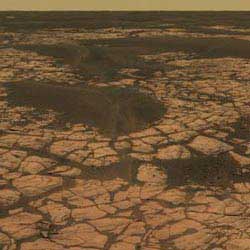NASA’s Mars Rovers Continue to Explore and Amaze

This view from the panoramic camera on NASA’s Mars Exploration Rover Opportunity shows an outcrop called "Olympia" along the northwestern margin of "Erebus" crater. The view spans about 120 degrees from side to side, generally looking southward. The outcrop exposes a broad expanse of sulfate-rich sedimentary rocks. The rocks were formed predominantly from windblown sediments, but some also formed in environmental conditions from damp to under shallow surface water. After taking the images that were combined into this view, Opportunity drove along along a path between sand dunes to the upper left side of the image, where a cliff in the background can be seen. This is a cliff is known as the "Mogollon Rim." Researchers expect it to expose more than 1 meter (3 feet) of new strata. These strata may represent the highest level observed yet by Opportunity. The image is an approximately true-color rendering generated using the panoramic camera’s 750-nanometer, 530-nanometer and 430-nanometer filters. Image Credit: NASA/JPL-Caltech/Cornell
NASA’s durable twin Mars rovers have successfully explored the surface of the mysterious red planet for a full Martian year (687 Earth days). Opportunity starts its second Martian year Dec. 11; Spirit started its new year three weeks ago. The rovers’ original mission was scheduled for only three months.
“The rovers went through all of the Martian seasons and are back to late summer,” said Dr. John Callas of NASA’s Jet Propulsion Laboratory, Pasadena, Calif. He is deputy rover project manager. “We’re preparing for the challenge of surviving another Martian winter.”
Both rovers keep finding new variations of bedrock in areas they are exploring on opposite sides of Mars. The geological information they collect increases evidence about ancient Martian environments including periods of wet, possibly habitable conditions.
Spirit is descending from the top of “Husband Hill” to examine a platform-like structure seen from the summit. It will then hurry south to another hill in time to position itself for maximum solar-cell output during the winter.
“Our speed of travel is driven as much by survival as by discovery, though the geology of Husband Hill continues to fascinate, surprise, puzzle and delight us,” said Dr. Steve Squyres of Cornell University, Ithaca, N.Y., principal investigator for the rover’s science instruments. “We’ve got this dramatic topography covered with sand and loose boulders, then, every so often, a little window into the bedrock underneath.”
From the composition and texture of more than six different types of rock inspected, scientists deduced what this part of Mars was like long ago. “It was a hot, violent place with volcanic explosions and impacts,” Squyres said. “Water was around, perhaps localized hot springs in some cases and trace amounts of water in other cases.
Aided by a good power supply from Spirit’s solar cells, researchers have been using the rover at night for astronomical observations. One experiment watched the sky during a meteor shower as Mars passed through the debris trail left by a passage of Halley’s comet. “We’re taking advantage of a unique opportunity to do some bonus science we never anticipated we would be able to do,” said Cornell’s Dr. Jim Bell, lead scientist for the rovers’ panoramic cameras
Opportunity is examining bedrock exposures along a route between Endurance and Victoria craters. It recently reached what appears to be a younger layer of bedrock than examined inside Endurance. In Endurance, the lowest layers of bedrock were deposited as windblown dunes. Some of the upper layers were deposited as underwater sediments, indicating a change from drier to wetter conditions over time.
The bedrock Opportunity began seeing about two-thirds of the way to Victoria appears to lie higher than the upper layers at Endurance, but its texture is more like the lowest layer, petrified sand dunes. This suggests the change from drier to wetter environmental conditions may have been cyclical.
Iron-rich granules are abundant in all the layers at Endurance but are much smaller in the younger bedrock. These granules were formed by effects of water soaking the rocks. One possibility for why they are smaller is these layers might have spent less time wet. Another is the material in these layers might have had a different chemistry to begin with.
Rover researchers are presenting their latest data today during the American Geophysical Union meeting in San Francisco. Images and information about the rovers and their discoveries are available on the Web at: http://www.nasa.gov/vision/universe/solarsystem/mer_main.html. For more information about NASA and agency programs on the Web, visit: http://www.nasa.gov/home .
Media Contact
All latest news from the category: Physics and Astronomy
This area deals with the fundamental laws and building blocks of nature and how they interact, the properties and the behavior of matter, and research into space and time and their structures.
innovations-report provides in-depth reports and articles on subjects such as astrophysics, laser technologies, nuclear, quantum, particle and solid-state physics, nanotechnologies, planetary research and findings (Mars, Venus) and developments related to the Hubble Telescope.
Newest articles

Bringing bio-inspired robots to life
Nebraska researcher Eric Markvicka gets NSF CAREER Award to pursue manufacture of novel materials for soft robotics and stretchable electronics. Engineers are increasingly eager to develop robots that mimic the…

Bella moths use poison to attract mates
Scientists are closer to finding out how. Pyrrolizidine alkaloids are as bitter and toxic as they are hard to pronounce. They’re produced by several different types of plants and are…

AI tool creates ‘synthetic’ images of cells
…for enhanced microscopy analysis. Observing individual cells through microscopes can reveal a range of important cell biological phenomena that frequently play a role in human diseases, but the process of…





















